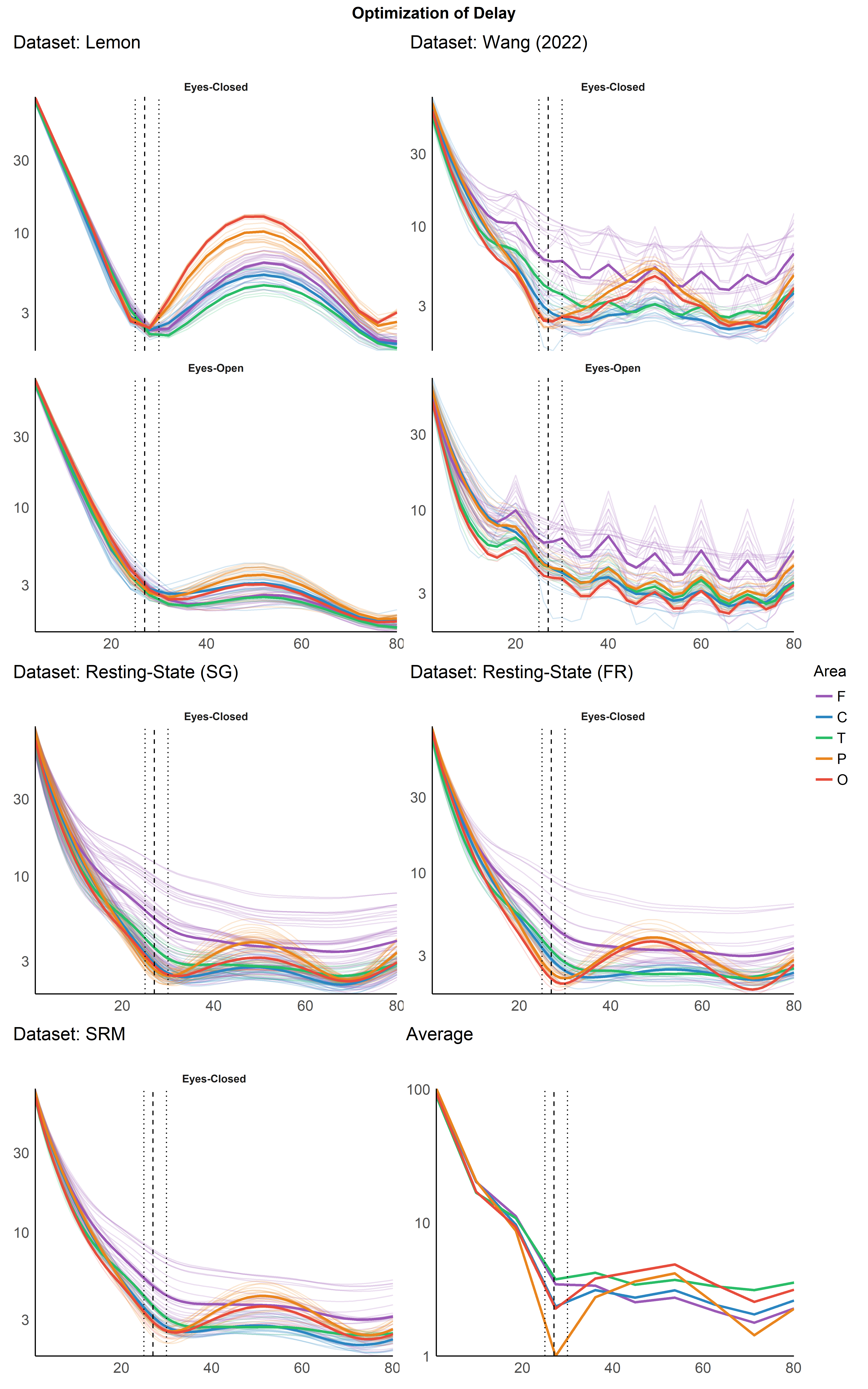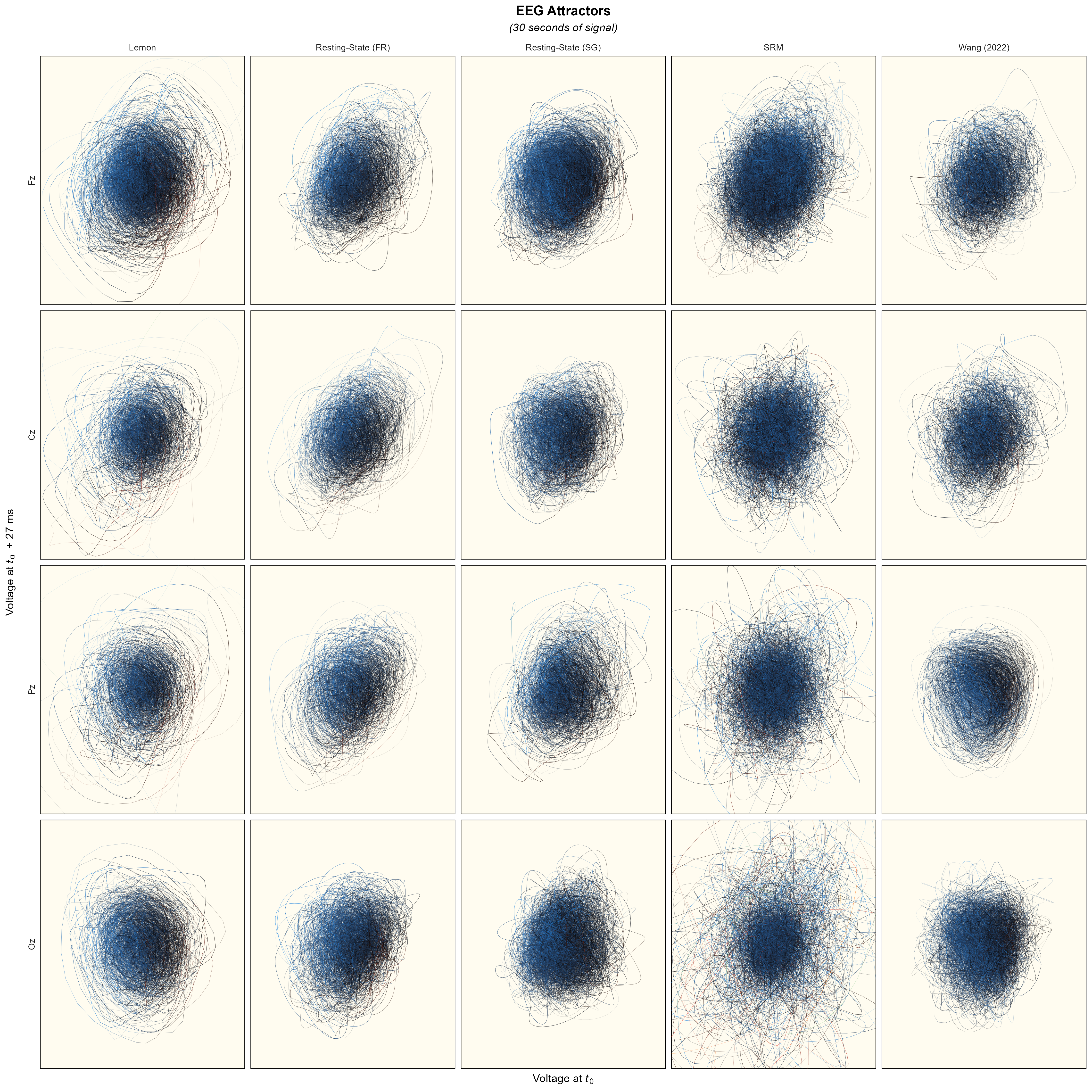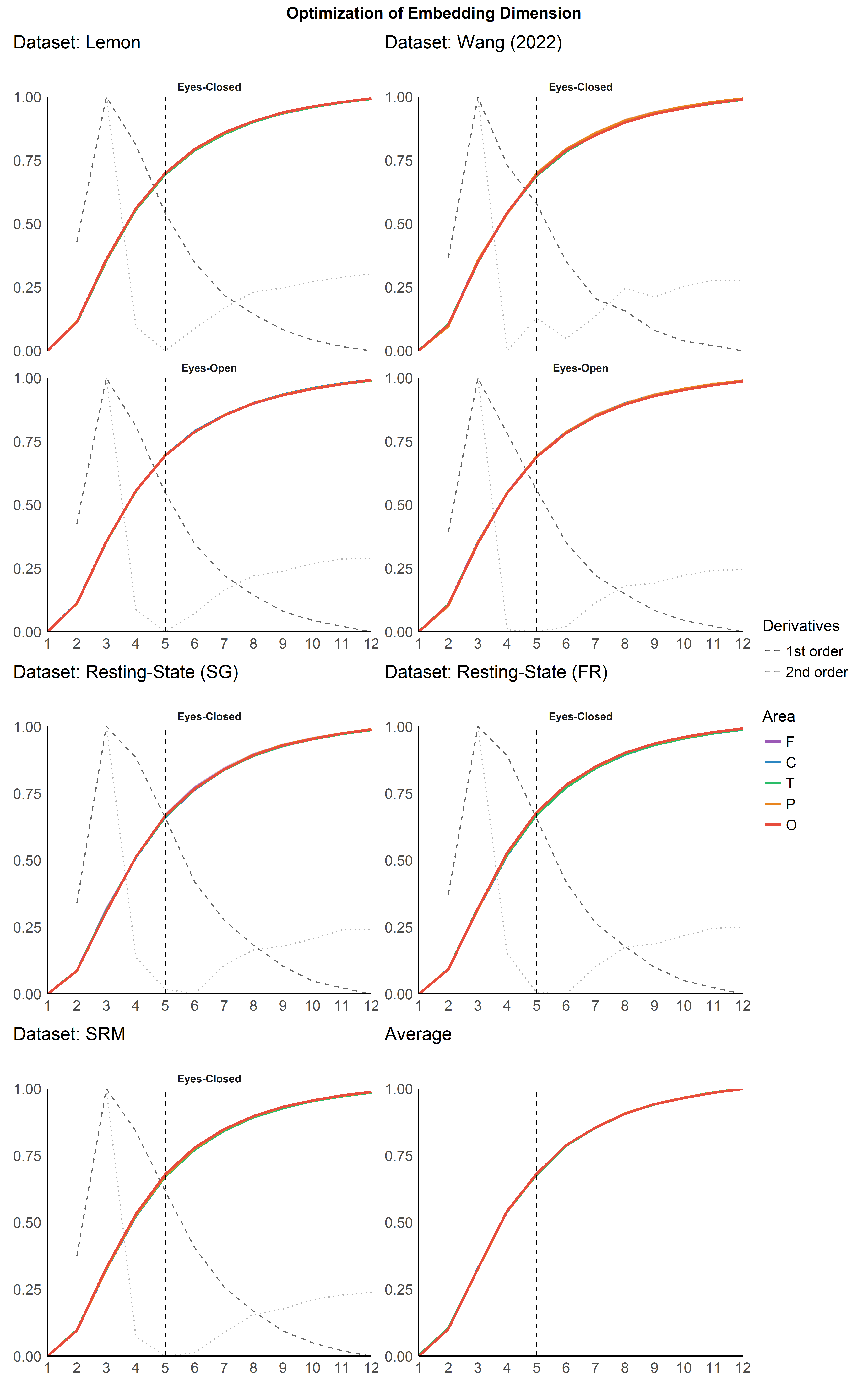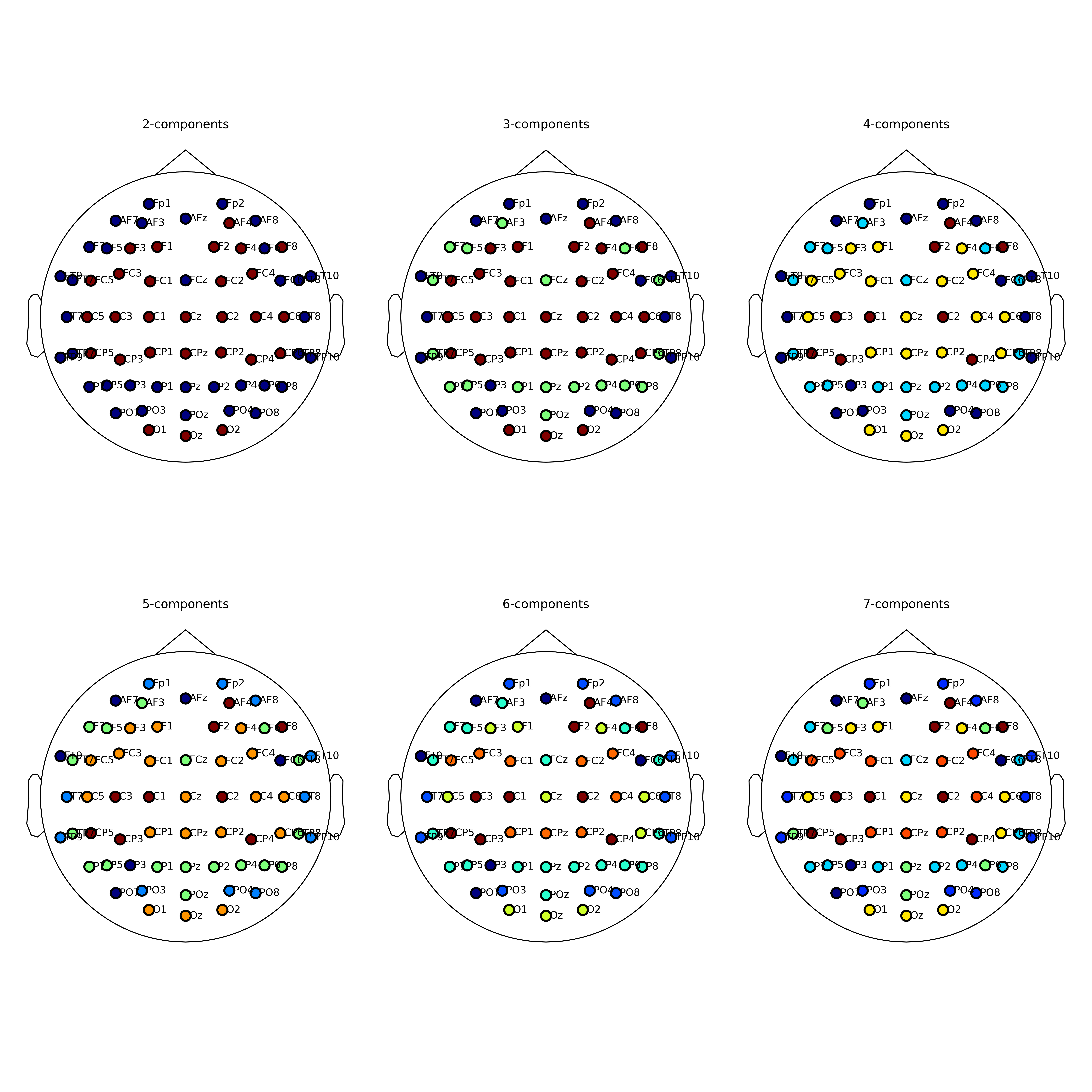Optimal Selection of Delay and Embedding Dimension for EEG Complexity Analysis#
This study can be referenced by citing the package and the documentation.
We’d like to improve this study, but unfortunately we currently don’t have the time. If you want to help to make it happen, please contact us!
Introduction#
The aim is to assess the optimal complexity parameters for EEG signals.
Methods#
library(tidyverse)
library(easystats)
library(patchwork)
read.csv("data_delay.csv") |>
group_by(Dataset) |>
summarise(Sampling_Rate = mean(Sampling_Rate),
Original_Frequencies = dplyr::first(Original_Frequencies),
Lowpass = mean(Lowpass),
n_Participants = n_distinct(Participant),
n_Channels = n_distinct(Channel))
## # A tibble: 5 × 6
## Dataset Sampling_Rate Original_Freque… Lowpass n_Participants n_Channels
## <chr> <dbl> <chr> <dbl> <int> <int>
## 1 Lemon 250 0.0-125.0 50 108 61
## 2 Resting-Stat… 1000 0.0-280.0 50 37 63
## 3 Resting-Stat… 1000 0.0-500.0 50 44 126
## 4 SRM 1024 0.0-512.0 50 111 64
## 5 Wang (2022) 500 0.0-250.0 50 59 62
Results#
Optimization of Delay#
data_delay <- read.csv("data_delay.csv") |>
mutate(Metric = fct_relevel(Metric, "Mutual Information"),
Value = Value/Sampling_Rate*1000,
Optimal = Optimal/Sampling_Rate*1000,
Optimal = Optimal) |>
mutate(Area = str_remove_all(Channel, "[:digit:]|z"),
Area = substring(Channel, 1, 1),
Area = case_when(Area == "I" ~ "O",
Area == "A" ~ "F",
TRUE ~ Area),
Area = fct_relevel(Area, c("F", "C", "T", "P", "O")))
# summarize(group_by(data_delay, Dataset), Value = max(Value, na.rm=TRUE))
# data_delay |>
# mutate(group = paste0(Dataset, "_", Metric)) |>
# estimate_density(method="kernel", select="Optimal", at = "group") |>
# separate("group", into = c("Dataset", "Metric")) |>
# ggplot(aes(x = x, y = y)) +
# geom_line(aes(color = Dataset)) +
# facet_wrap(~Metric, scales = "free_y")
Per Channel Delay Optimization#
delay_perchannel <- function(data_delay, dataset="Lemon") {
data <- filter(data_delay, Dataset == dataset) |>
group_by(Metric) |>
mutate(Score = 1 + normalize(Score) * 100) |>
ungroup()
by_channel <- data |>
group_by(Condition, Metric, Area, Channel, Value) |>
summarise_all(mean, na.rm=TRUE)
by_area <- data |>
group_by(Condition, Metric, Area, Value) |>
summarise_all(mean, na.rm=TRUE)
p <- by_channel |>
ggplot(aes(x = Value, y = Score, color = Area)) +
geom_line(aes(group=Channel), alpha = 0.20) +
geom_line(data=by_area, aes(group=Area), size=1) +
geom_vline(xintercept = c(27), linetype = "dashed", size = 0.5) +
geom_vline(xintercept = c(25, 30), linetype = "dotted", size = 0.5) +
see::scale_color_flat_d(palette = "rainbow") +
scale_y_log10(expand = c(0, 0)) +
scale_x_continuous(expand = c(0, 0)) +
# limits = c(0, NA),
# breaks=c(5, seq(0, 80, 20)),
# labels=c(5, seq(0, 80, 20))) +
labs(title = paste0("Dataset: ", dataset), x = NULL, y = NULL) +
guides(colour = guide_legend(override.aes = list(alpha = 1))) +
see::theme_modern() +
theme(plot.title = element_text(face = "plain", hjust = 0))
if(length(unique(data$Condition)) > 1) {
p <- p + facet_wrap(~Condition, scales = "free_y", nrow=2)
} else {
p <- p + facet_wrap(~Condition, scales = "free_y", nrow=1)
}
p
}
p1 <- delay_perchannel(data_delay, dataset="Lemon")
p2 <- delay_perchannel(data_delay, dataset="SRM")
p3 <- delay_perchannel(data_delay, dataset="Wang (2022)")
p4 <- delay_perchannel(data_delay, dataset="Resting-State (SG)")
p5 <- delay_perchannel(data_delay, dataset="Resting-State (FR)")
m <- mgcv::bam(Score ~ s(Value, by=Area, k=-1, bs="cs") +
s(Dataset, bs="re"),
data=data_delay |>
mutate(Dataset=as.factor(Dataset)))
p6 <- estimate_relation(m, at=c("Value", "Area"), show_data=FALSE) |>
mutate(Predicted = 1 + normalize(Predicted) * 100) |>
ggplot(aes(x = Value, y = Predicted, color = Area)) +
geom_line(size=1) +
geom_vline(xintercept = c(27), linetype = "dashed", size = 0.5) +
geom_vline(xintercept = c(25, 30), linetype = "dotted", size = 0.5) +
see::scale_color_flat_d(palette = "rainbow") +
scale_y_log10(expand = c(0, 0)) +
scale_x_continuous(expand = c(0, 0)) +
labs(title = "Average", x = NULL, y = NULL) +
see::theme_modern() +
guides(color="none")
# p6 <- data_delay |>
# group_by(Area, Value) |>
# summarise(Score = mean(Score)) |>
# mutate(Score = 1 + normalize(Score) * 100) |>
# ggplot(aes(x = Value, y = Score, color = Area)) +
# # geom_point2(size=3, alpha=0.3) +
# geom_line(size=0.5) +
# geom_smooth(size=1, se=FALSE, method = 'loess') +
# geom_vline(xintercept = c(27), linetype = "dashed", size = 0.5) +
# see::scale_color_flat_d(palette = "rainbow") +
# scale_y_log10(expand = c(0, 0)) +
# scale_x_continuous(expand = c(0, 0)) +
# labs(title = "Average", x = NULL, y = NULL) +
# see::theme_modern() +
# guides(color="none")
(p1 | p3) / (p4 | p5) / (p2 | p6) + plot_layout(heights = c(2, 1, 1), guides="collect") +
plot_annotation(title = "Optimization of Delay", theme = theme(plot.title = element_text(hjust = 0.5, face = "bold")))

Attractors#
data <- read.csv("data_attractor.csv")
p <- data |>
mutate(Delay = Delay/Sampling_Rate*1000,
Channel = fct_relevel(Channel, "Fz", "Cz", "Pz", "Oz"),
z = normalize(z)) |>
ggplot(aes(x = x, y = y)) +
geom_path(aes(alpha=Time, color=z), size=0.1) +
facet_grid(Channel~Dataset, scales="free", switch="y") +
guides(alpha="none") +
labs(title = "EEG Attractors",
subtitle = "(30 seconds of signal)",
x = expression("Voltage at"~italic(t[0])),
# y = expression("Voltage at"~italic(t[0]~+~"τ")~" (27 ms)"),
y = expression("Voltage at"~italic(t[0])~" + 27 ms")) +
scale_y_continuous(expand = c(0, 0)) +
scale_x_continuous(expand = c(0, 0)) +
# scale_color_manual(values=c("Fz"="#4A148C", "Cz"="#1B5E20", "Pz"="#E65100", "Oz"="#F57F17")) +
# scale_color_manual(values=c("Fz"="#18062E", "Cz"="#09200A", "Pz"="#4C1B00", "Oz"="#512B07")) +
scale_colour_gradientn(colours = c("#FF9800", "#F44336", "black", "#1E88E5", "#4CAF50"), guide="none") +
coord_cartesian(xlim = c(-5, 5), ylim = c(-5, 5)) +
theme_minimal() +
theme(panel.background = element_rect(fill = "#FFFCF0"),
panel.grid.major = element_blank(),
panel.grid.minor = element_blank(),
axis.text = element_blank(),
axis.ticks = element_blank(),
plot.title = element_text(hjust = 0.5, face = "bold"),
plot.subtitle = element_text(hjust = 0.5, face = "italic"))
ggsave("figures/attractors2D.png", width=15, height=15, dpi=300)

Optimization of Dimension#
data_dim <- read.csv("data_dimension.csv") |>
mutate(Area = str_remove_all(Channel, "[:digit:]|z"),
Area = substring(Channel, 1, 1),
Area = case_when(Area == "I" ~ "O",
Area == "A" ~ "F",
TRUE ~ Area),
Area = fct_relevel(Area, c("F", "C", "T", "P", "O")))
Per Channel Dimension Optimization#
dim_perchannel <- function(data_dim, dataset="Lemon") {
data <- filter(data_dim, Dataset == dataset) |>
mutate(Score = normalize(Score))
by_channel <- data |>
group_by(Condition, Area, Channel, Value) |>
summarise_all(mean, na.rm=TRUE)
by_area <- data |>
group_by(Condition, Area, Value) |>
summarise_all(mean, na.rm=TRUE)
deriv <- data |>
group_by(Condition, Value) |>
summarise_all(mean, na.rm=TRUE) |>
mutate(Score = normalize(Score - lag(Score)),
Score2 = normalize(Score - lag(Score)))
by_channel |>
mutate(Value = as.factor(Value)) |>
ggplot(aes(x = Value, y = Score)) +
geom_line(data=deriv, aes(alpha = "1st order"), linetype="dashed") +
geom_line(data=deriv, aes(y=Score2, alpha="2nd order"), linetype="dotted") +
geom_line(aes(group=Channel, color = Area), alpha = 0.20) +
geom_line(data=by_area, aes(group=Area, color = Area), size=1) +
geom_vline(xintercept = c(5), linetype = "dashed", size = 0.5) +
facet_wrap(~Condition, ncol=1, scales = "free_y") +
see::scale_color_flat_d(palette = "rainbow") +
scale_y_continuous(expand = c(0, 0)) +
scale_x_discrete(expand = c(0, 0)) +
scale_alpha_manual(values=c("1st order"=0.6, "2nd order"=0.3)) +
labs(title = paste0("Dataset: ", dataset), x = NULL, y = NULL, alpha="Derivatives") +
guides(colour = guide_legend(override.aes = list(alpha = 1))) +
see::theme_modern() +
theme(plot.title = element_text(face = "plain", hjust = 0))
}
p1 <- dim_perchannel(data_dim, dataset="Lemon")
p2 <- dim_perchannel(data_dim, dataset="SRM")
p3 <- dim_perchannel(data_dim, dataset="Wang (2022)")
p4 <- dim_perchannel(data_dim, dataset="Resting-State (SG)")
p5 <- dim_perchannel(data_dim, dataset="Resting-State (FR)")
m <- mgcv::bam(Score ~ s(Value, by=Area, k=-1, bs="cs") +
s(Dataset, bs="re"),
data=data_dim |>
mutate(Dataset=as.factor(Dataset)))
p6 <- estimate_relation(m, at=list("Value" = unique(data_dim$Value),
"Area" = unique(data_dim$Area))) |>
mutate(Predicted = normalize(Predicted)) |>
ggplot(aes(x = as.factor(Value), y = Predicted, color = Area)) +
geom_line(aes(group=Area), size=1) +
geom_vline(xintercept = c(5), linetype = "dashed", size = 0.5) +
see::scale_color_flat_d(palette = "rainbow") +
scale_y_continuous(expand = c(0, 0)) +
scale_x_discrete(expand = c(0, 0)) +
labs(title = "Average", x = NULL, y = NULL) +
see::theme_modern() +
guides(color="none")
(p1 | p3) / (p4 | p5) / (p2 | p6) + plot_layout(heights = c(2, 1, 1), guides="collect") +
plot_annotation(title = "Optimization of Embedding Dimension", theme = theme(plot.title = element_text(hjust = 0.5, face = "bold")))

Topological Clusters#
df <- read.csv("data_complexity.csv") |>
mutate(Channel = ifelse(Channel=="Cpz", "CPz", Channel))
data <- df |>
pivot_longer(-c(Channel, Participant, Condition, Dataset),
names_to = "Index", values_to = "Value") |>
group_by(Dataset, Condition, Index) |>
mutate(Value = standardize(Value)) |>
ungroup()
data_varex <- data.frame()
data_clusters <- list()
for(dataset in unique(df$Dataset)) {
dat1 <- data[data$Dataset == dataset, ]
print(dataset)
list_clusters <- list()
for(condition in unique(dat1$Condition)) {
dat2 <- dat1[dat1$Condition == condition, ]
for(index in unique(dat2$Index)) {
dat3 <- dat2[dat2$Index == index, ] |>
pivot_wider(values_from = "Value", names_from = "Channel") |>
select_if(is.numeric) |>
data_transpose()
dat3[is.na(dat3)] <- 0
for(n in 2:10) {
for(method in c("hkmeans", "pam", "hclust")) {
rez <- parameters::cluster_analysis(dat3, n=n, method=method)
perf <- attributes(rez)$performance
varex <- data.frame(Clusters=n,
Variance=perf$R2,
Dataset=dataset,
Condition=condition,
Index=index,
Method = method)
data_varex <- rbind(data_varex, varex)
list_clusters[[paste0(index, n, condition, method)]] <- setNames(predict(rez), row.names(dat3))
}
}
}
}
data_clusters[[dataset]] <- cluster_meta(list_clusters)
}
## [1] "Lemon"
## [1] "SRM"
## [1] "Wang (2022)"
## [1] "Resting-State (SG)"
## [1] "Resting-State (FR)"
data_varex |>
filter(Method == "hkmeans") |>
ggplot(aes(x=Clusters, y=Variance)) +
geom_line(aes(color=Index)) +
facet_grid(Dataset~Condition)

structures <- list()
for(n in 2:7) {
for(dataset in unique(df$Dataset)) {
structures[[paste0(n, "_", dataset)]] <- predict(data_clusters[[dataset]], n=n)
}
}
ch_names <- lapply(structures, function(x) names(x))
structures <- lapply(structures, function(x) as.character(x))
# predict.cluster_meta(m, n=4)
# heatmap(m)
import TruScanEEGpy
import mne
import numpy as np
import matplotlib.pyplot as plt
import matplotlib
matplotlib.use("Agg")
matplotlib.rcParams['axes.linewidth'] = 0
def plot_layout(closest, closest_names, **kwargs):
if "Iz" not in closest_names:
info = mne.create_info(closest_names, ch_types="eeg", sfreq=4000)
info = info.set_montage(montage="easycap-M1")
else:
montage = TruScanEEGpy.montage_mne_128(TruScanEEGpy.layout_128('10-5'))
info = mne.create_info(montage.ch_names, ch_types="eeg", sfreq=3000)
info = info.set_montage(montage)
groups = []
for group in np.unique(closest):
channels = np.array(closest_names)[np.array(closest) == group]
groups.append(mne.pick_channels(info['ch_names'], include=channels))
mne.viz.plot_sensors(info, ch_groups=groups, **kwargs)
def make_plot(dataset="Lemon"):
fig = plt.figure(figsize=(15, 15))
for i in range(1, 7):
ax = fig.add_subplot(2, 3, i, title = str(i+1) + "-components")
plot_layout(r.structures[str(i+1) + "_" + dataset], r.ch_names[str(i+1) + "_" + dataset], show_names=True, kind='topomap', pointsize=100, axes=ax)
fig.tight_layout()
return fig
fig1 = make_plot(dataset="Lemon")
plt.show()

fig2 = make_plot(dataset="SRM")
plt.show()

fig3 = make_plot(dataset="Wang (2022)")
plt.show()

fig4 = make_plot(dataset="Resting-State (SG)")
plt.show()

fig5 = make_plot(dataset="Resting-State (FR)")
plt.show()

Discussion#
In conclusion, the optimal delay for resting state EEG, accross different datasets, was estimated to be between 25 and 30 ms. 27 ms, which corresponds to a frequency of 37.037 Hz, is a possible value.
